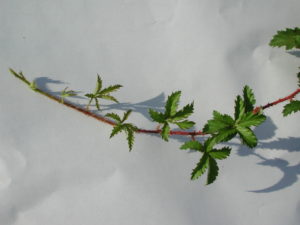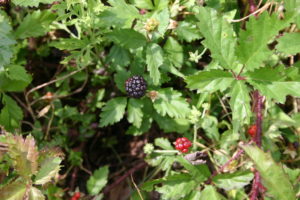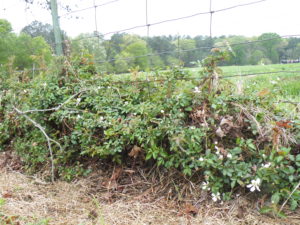Source: ForageFax | April 12, 2019
Blackberry and dewberry are closely related, but they are very different in growth habits and physical characteristics. Dewberry exhibits a low, vine-like, trailing growth habit that forms mats that are rarely taller than 2 feet above the ground. Blackberry typically has an upright rambling growth habit, which can form impenetrable thickets that are often 4 to 6 feet tall.
Stems of dewberry have slender thorns and numerous red hairs, while upright blackberry stems have few to no hairs and numerous hard, broad-based thorns. Dewberry also tend to flower about one to two months earlier in the spring than blackberry.

Mowing or hay cutting alone WILL NOT control dewberry or blackberry. It may temporarily reduce the size or top growth of these weeds, but they will rapidly recover.
If blackberry or dewberry has been mowed, best control results have been observed when a herbicide application is made in the following year.

Blackberry and Dewberry are most sensitive to herbicides when blooming in late spring and in the fall prior to frost. Applications made soon after emergence from winter dormancy or during fruit production are generally less effective.
It is also important that the plants are not drought-stressed at the time of herbicide application.
Make sure the sprayer is properly calibrated, and always read and follow directions on the herbicide label of any product you use. You will likely need to retreat for several years to get on top of the problem. Similar to many other pasture weeds, both blackberry and dewberry species may form persistent seed banks in the soil, and the roots are difficult to completely kill with any management approach. However, with persistence, these weeds can be effectively managed.

Select Herbicide Options:
- Chaparral (will kill bahiagrass)
- Cimarron Plus (will kill bahiagrass)
- RemedyUltra
- Pasturegard HL
- Surmount
Note that Pasturegard HL, RemedyUltra and Surmount may be less effective if mowing has occurred within a year prior to treatment for either species.
Vanessa Corriher-Olson
Associate Professor, Forage Extension Specialist
Soil & Crop Sciences, Texas A&M AgriLife Extension, Overton
